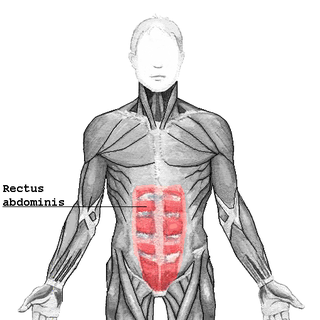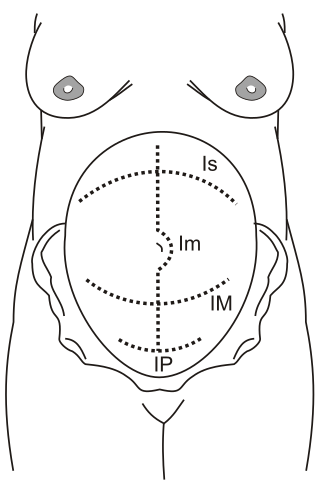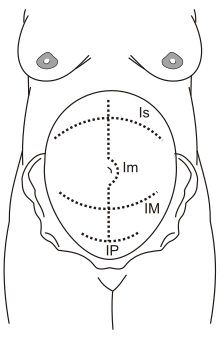A laparotomy is a surgical procedure involving a surgical incision through the abdominal wall to gain access into the abdominal cavity. It is also known as a celiotomy.

The linea alba is a strong fibrous midline structure of the anterior abdominal wall situated between the two recti abdominis muscles. The umbilicus (navel) is a defect in the linea alba through which foetal umbilical vessels pass before birth. The linea alba is formed by the union of aponeuroses that collectively make up the rectus sheath. The linea alba attaches to the xiphoid process superiorly, and to the pubic symphysis inferiorly. If is narrow inferiorly where the two recti abdominis muscles are in contact with each other posterior to it, and broadens superior-ward from just inferior to the umbilicus.
Abdominal muscles cover the anterior and lateral abdominal region and meet at the anterior midline. These muscles of the anterolateral abdominal wall can be divided into four groups: the external obliques, the internal obliques, the transversus abdominis, and the rectus abdominis.

The rectus abdominis muscle, also known as the "abdominal muscle" or simply the "abs", is a pair of segmented skeletal muscle on the ventral aspect of a person's abdomen. The paired muscles are separated at the midline by a band of dense connective tissue called the linea alba, and the connective tissue defining each lateral margin of the rectus abdominus is the linea semilunaris. The muscle extends from the pubic symphysis, pubic crest and pubic tubercle inferiorly, to the xiphoid process and costal cartilages of the 5th–7th ribs superiorly.

The transverse abdominal muscle (TVA), also known as the transverse abdominis, transversalis muscle and transversus abdominis muscle, is a muscle layer of the anterior and lateral abdominal wall, deep to the internal oblique muscle. It is thought by most fitness instructors to be a significant component of the core.

The pyramidalis muscle is a small triangular muscle, anterior to the rectus abdominis muscle, and contained in the rectus sheath.

The abdominal internal oblique muscle, also internal oblique muscle or interior oblique, is an abdominal muscle in the abdominal wall that lies below the external oblique muscle and just above the transverse abdominal muscle.

The abdomen is the part of the body between the thorax (chest) and pelvis, in humans and in other vertebrates. The abdomen is the front part of the abdominal segment of the torso. The area occupied by the abdomen is called the abdominal cavity. In arthropods, it is the posterior tagma of the body; it follows the thorax or cephalothorax.

In human anatomy, the inferior epigastric artery is an artery that arises from the external iliac artery. It is accompanied by the inferior epigastric vein; inferiorly, these two inferior epigastric vessels together travel within the lateral umbilical fold The inferior epigastric artery then traverses the arcuate line of rectus sheath to enter the rectus sheath, then anastomoses with the superior epigastric artery within the rectus sheath.

In vertebrates, the pubis or pubic bone forms the lower and anterior part of each side of the hip bone. The pubis is the most forward-facing of the three bones that make up the hip bone. The left and right pubic bones are each made up of three sections, a superior ramus, inferior ramus, and a body.

The conjoint tendon is a sheath of connective tissue formed from the lower part of the common aponeurosis of the abdominal internal oblique muscle and the transversus abdominis muscle, joining the muscle to the pelvis. It forms the medial part of the posterior wall of the inguinal canal.

The pubic tubercle is a prominent tubercle on the superior ramus of the pubis bone of the pelvis.

The arcuate line of rectus sheath is a line of demarcation corresponding to the free inferior margin of the posterior layer of the rectus sheath inferior to which only the anterior layer of the rectus sheath is present and the rectus abdominis muscle is therefore in direct contact with the transversalis fascia. The arcuate line is concave inferior-wards.

The rectus sheath is a tough fibrous compartment formed by the aponeuroses of the transverse abdominal muscle, and the internal and external oblique muscles. It contains the rectus abdominis and pyramidalis muscles, as well as vessels and nerves.

A Pfannenstiel incision, Kerr incision, Pfannenstiel-Kerr incision or pubic incision is a type of abdominal surgical incision that allows access to the abdomen. It is used for gynecologic and orthopedics surgeries, and it is the most common method for performing Caesarian sections today. This incision is also used in Stoppa approach for orthopedics surgeries to treat pelvic fractures.

The following outline is provided as an overview of and topical guide to human anatomy:

The hip bone is a large flat bone, constricted in the center and expanded above and below. In some vertebrates it is composed of three parts: the ilium, ischium, and the pubis.

The pelvis is the lower part of the trunk, between the abdomen and the thighs, together with its embedded skeleton.

Maylard incision is a surgical incision in which a transverse cut is made on rectus abdominis muscle to allow wider access to the pelvic cavity. It is also called Mackenrodt incision. For gynaecological surgery, the skin incision is made 5–8 cm above the pubic symphysis. The site of skin incision is above and parallel to traditional Pfannenstiel incision. The rectus fascia and muscle are cut transversely and the incision is extended as far laterally as needed. The anterior rectus sheath is not separated from the muscle to facilitate easy closure at the end of the surgical procedure. The inferior epigastric vessels which span across more than half of the rectus muscle's width are identified and ligated. In patients with peripheral arterial disease, ligation of inferior epigastric vessels may lead to distal ischemia. Finally, the peritoneum is cut laterally.
The Modified Gibson incision is a transverse incision above the pubis, frequently used in gynecological and urological surgeries. This incision can be made on either side of the midline, but often on the left. It is started 3 cm above and parallel to the inguinal ligament and extended vertically 3 cm medial to the anterior superior iliac spine up to the umbilicus. The modified Gibson incision allows proper access to the small bowel and pelvic organs and limited access to omentum. It is also possible to have tactile assessment of large bowel and subdiaphragmatic surfaces using this incision. This incision is preferred for lymph node dissection, as extra peritoneal approach of pelvic sidewall is possible. The inferior epigastric vessels and round ligament are ligated to provide easy exposure. If traction to the peritoneum is high, there is a chance for avulsion of the inferior mesenteric artery and inferior mesenteric vein.
















